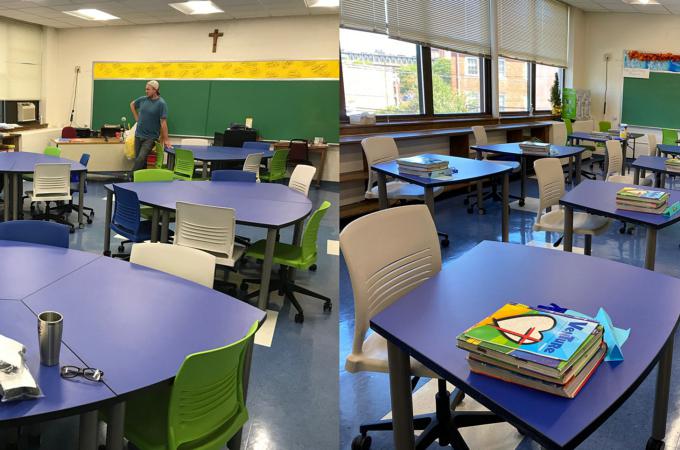Forming the Future: 'Flexible furniture' fosters collaboration at IC School, Newburyport
NEWBURYPORT -- Even before the coronavirus pandemic prompted the rearranging of classrooms, some of the learning spaces at Immaculate Conception School looked different than a typical classroom setup.
Instead of stationary desks and chairs arranged in rows, the middle school grades and some specialist classrooms have been furnished with "flexible furniture," colorful wheeled desks and chairs, which have allowed greater collaboration between students -- and proved even more useful when returning to in-person learning.
"Our classrooms are not just classrooms," Principal Joan Sullivan said. Because the desks can easily be set up, rearranged, and folded up for storage, a classroom can quickly and quietly be transformed into a new environment: a rehearsal space for the choir, a stage for acting out skits, or a studio for an after-school yoga class.
"Literally, a kindergartener can do it. It's that easy," Sullivan said in a March 26 interview.
The school obtained the furniture during the 2019-2020 school year, thanks to a donor who enabled them to purchase it outright. Sullivan worked with KI Furniture and Catholic Purchasing Services to establish floor plans and select pieces.
Before the furniture arrived, she had samples brought in for students and their parents to see at their open house during Catholic Schools Week. That allowed parents to try the furniture and experience for themselves how different it would be.
Fifth-grade teacher Bridget Lacefield said the flexible furniture "breathed new life into the classroom." She saw a change in her students from the very first day they used it, returning from winter vacation in January 2020.
"It was an amazing moment. They came back in and thought that they had just received the best Christmas present ever. It definitely elevated the classroom to a different learning environment," Lacefield said.
She said the students saw it as receiving "grown-up furniture." As a result, "They took everything they did a little more seriously."
She always asked her students to talk to each other about what they did over their vacation, which always seemed to be difficult for them. But in their new swivel chairs, students readily turned to each other, looked each other in the eye, and engaged with each other even without being asked to do so.
Sullivan said this result is "one of the known responses that people have when they sit in this type of flexible furniture that is comfortable and meant for collaborating."
Lacefield attributed the change to the students' increased ability to have eye contact, which is easier to do when they can turn in their swivel chairs, instead of twisting around in a stationary chair.
"They're able to adjust themselves much easier to wherever the person who is speaking is," she said.
The students also felt a sense of being on a team as they sat at interconnected desks arranged in "pods." They even went so far as to name their pods.
Lacefield noted that because the chairs' heights can be easily adjusted, they provide "an even playing field" for her students, who range in height from three feet to five feet. Now they can all sit comfortably at their desks no matter their size.
Another thing they appreciate about the flexible furniture, Sullivan said, is that it allows children to move easily and quietly during class, letting out their energy while staying at their seats.
"Some students need to move in order to focus. They need to move in order to just sustain their attention. And that is very much fostered with the use of this furniture," Sullivan said.
The furniture proved even more valuable when the school returned to in-person learning during the coronavirus pandemic. To follow social distancing guidelines, the school used some of the wheeled furniture to create a new learning space in the gym, providing each student with a more expansive workspace.
Technology coordinator Laura Capobianco said one of the school's focuses is "using technology with a purpose." This is evident in their coding programs for all grades and their one-to-one Chromebook program.
"It's not enough just to substitute, it's what can the students create with this, how can we take this learning to the next level," she explained.
They have floor plans for all the classrooms, as young as kindergarten, which they hope to furnish with flexible furniture in a second phase of this initiative.
"We have a lot of goals set for ourselves that we're hoping to accomplish," Capobianco said.



















